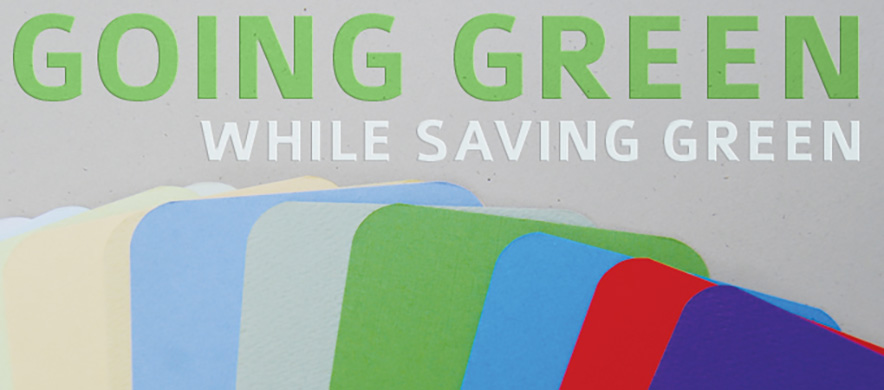Going Green While Saving Green

With Earth Day approaching, we may all think a bit more about how we can be less wasteful and tread more lightly on the Earth. It makes us as designers think about our responsibility when it comes to paper and printing choices.
With so many companies choosing to put their resources into digital and online marketing efforts, there is still something to be said about printed marketing materials. The touch, feel and weight of a printed piece is still sometimes the best way to communicate an idea or promote a product or service.
Many paper options now include recycled or post-consumer content. Contrary to popular belief, recycled paper is not necessarily more expensive than conventional paper choices. Due to the greater demand of recycled paper, there are now many great economical options. But what’s the difference between post-consumer and recycled paper and why should it matter?
Recycled paper
Recycled paper is a general term for paper that contains recycled fiber. It can be made of either 100% discarded post-consumer paper, or a mix of post-consumer and pre-consumer paper, or a mix of post-consumer and either FSC Certified or just regular, non certified paper.
Post-consumer paper vs. Pre-consumer
Post-consumer paper has been used by consumers and returned for recycling, such as old magazines, newspapers, office paper waste etc. The ink is removed from the recycled pulp and turned back into paper. Pre-consumer paper has not been used by a consumer, typically paper and envelope trimmings, or paper discarded during the paper-making process.
FSC certification
FSC stands for Forest Stewardship Council. If all the criteria of the FSC are met by the management of the forest, then the forest will receive an FSC Certification. FSC Certified paper is paper made from wood taken from trees from a well managed forest. The wood was harvested with the utmost care and concern for the forest and its surrounding ecosystem. When trees are logged from an uncertified forest, it puts greater strain on its surrounding ecosystem. Nearly 80% of the world’s original old growth forests have been logged or severely degraded.
So why consider choosing recycled paper?
– Producing recycled paper uses up to 70% less energy than virgin paper
– Reduced landfill waste and methane emissions
– Places less strain on forests and ecosystems
What other ways can you be more green with your printed marketing pieces?
Use Vegetable / Soy Inks
Some printing inks contain hazardous materials. These range from heavy metals used in coloring to petroleum-based solvents. When leached into the environment, heavy metals such as barium, copper, and zinc can contaminate soil and groundwater. In addition, inks that contain petroleum solvents emit volatile organic compounds (VOC) into the air. VOCs can be irritants for print shop workers. They also contribute to the formation of smog.
Soy and other vegetable-based inks are less harmful to the environment than their petroleum-based counterparts. Soy is also a renewable resource. Using soy and vegetable based ink reduces VOC emissions and the exposure to heavy metal toxins. Today, these inks are very competitively priced against petroleum-based inks due to the increasing demand.
Reduce Undeliverable Mail
Each year almost 60 billion pieces of direct mail end up in landfills. An estimated 43 million Americans pick up and move every year. Keeping your database up to date can save you hundreds on your mailing campaign. Data quality and mail preparation software is available that can help you identify bad addresses. You can submit your mailing list to USPS-licensed vendors that match your addresses against the database of individuals and businesses that have filed a change of address with the postal service.
If you are creating a marketing piece and need assistance with designing a professional layout, selecting the right recycled paper and finding a “green” printer, please contact us to help you with your Brand Building By Design.
